


The way I see it, my semester has been divided into four sections. For the month of January, I took a geography class on Central America with Heidi Michelsen, a Valpo professor, at Casa Adobe, the Valparaiso Study Abroad Center in Costa Rica. In February, I took six credits of Spanish at the University of Costa Rica and continued my class with Heidi. For these months, I was with my Valparaiso cohort, the other four students who are studying here and living in Santa Rosa from Valpo with me. In March, I separated from the usual Valpo program. While the other VU students began internships, I joined nine other students from various places across the United States in a field biology research program at ICADS, the Institute for Central American Development Studies. In January and February, those students had taken classes in Geography and Spanish similar to what I had done. This section of the program was called “Block 1.” In March, we began “Block 2.”
The focus of Block 2 was exactly what I had come to Costa Rica for. We traveled all over the country and we studied the environments we were in as they related to human geography, and sustainability of both human society and the natural environment. We traveled to two different places each week, staying 2 or 3 nights in each location, either in a lodge or with a host family. We touched base at our host families in San Jose, or in my case in Santa Rosa, briefly on the weekends. First we went to Longo Maï {Red Arrow on the map below}, a commune made up of El Salvadoran refugees. (Check out my blog solely about Longo Maï!) Second we went to Villa Mills {Orange Arrow}, one of the highest places in elevation in Costa Rica, where we did bird watching. Third we went to El Yuë {Yellow Arrow}, where we stayed in a lodge built for rural community tourism. Here we visited agroforestry farms and Cahuita, a beautiful beach. Fourth we went to Puerto Viejo {Green Arrow} for a couple of nights, which is a common place for many tourists to visit in Costa Rica, with its beautiful beaches and thrilling night life. During our stay there, we visited the Indigenous community of Bribri. Fifth we went to Isla de Chita {Dark Blue Arrow}, which is an island in between the Peninsula of Guanacaste and the mainland. Here we had the opportunity to go into a mangrove and learn how to harvest pianguas by the roots. Sixth we went to the community of Ortega {Purple Arrow}, in the mainland of Guanacaste, where we learned about the sugarcane plantation, what life is like in the community, and community opinions on tourism. Having seeing all these places, I feel like this program has truly given me a chance to see many different places in Costa Rica. What a great way to learn about a country.
The past three weeks have been an intense and exciting learning experience. One thing that greatly impacted the experience for me was the fact that, aside from in Puerto Viejo, I did not have any access to WiFi and very limited cellular connection. This allowed to me to “unplug” and focus more on my experience in the communities I was in. The people in these communities live a simpler life than I am used to. They live more slowly than I am used to, and most need to focus on the land and the local community around them. This gives me a new perspective on my fast-pace western life-style, where it is common for a lot of people to have no interactions with their neighbors. Being in these communities, which I was not used to, and speaking a language that is not my first language required me to be intentional about forming relationships, having conversations, and figure out what my host families rhythm of life was like.
The field experience I gained from my time was also invaluable. I had a chance to dip my toes into many methods of research, both for ecological and social purposes. We analyzed the biodiversity of insects on an agroforestry farm, tree and plant density on the agroforestry farm, the sustainability of harvesting a species (pianguas) from its natural environment, biodiversity of birds in both a region with human activity and in an undisturbed area, community relations with a monoculture pineapple plantation (Pindeco), community relations with tourists, challenges in rural youth education, and we participated in aquatic river monitoring by catching and identifying fish and macroinvertebrates. I have learned so much about conducting research and about the areas we visited in Costa Rica. These past three weeks of March has to have been one of the most influential and educational experiences I have had in college. I highly recommend this program to any Environmental Science or Geography student who is planning on studying abroad.
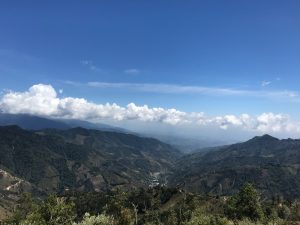
A view in Villa Mills.
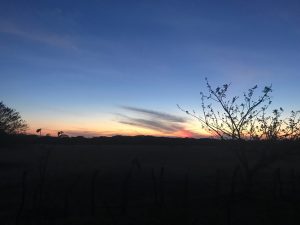
A view of the sunset in Ortega.
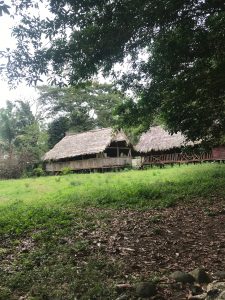
Buildings in the Indigenous community of Bribri.
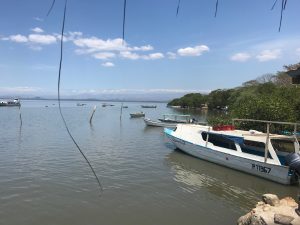
The boat which took us to and from Isla de Chita.
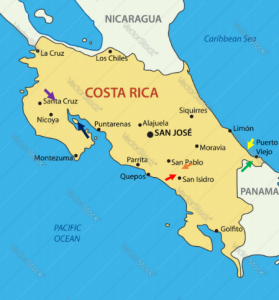
Map of Costa Rica with the approximate locations of places we stayed.